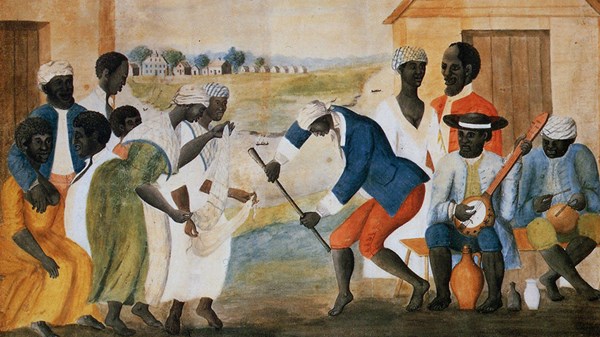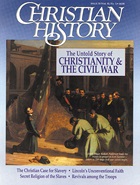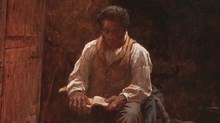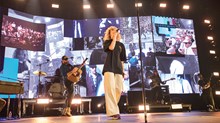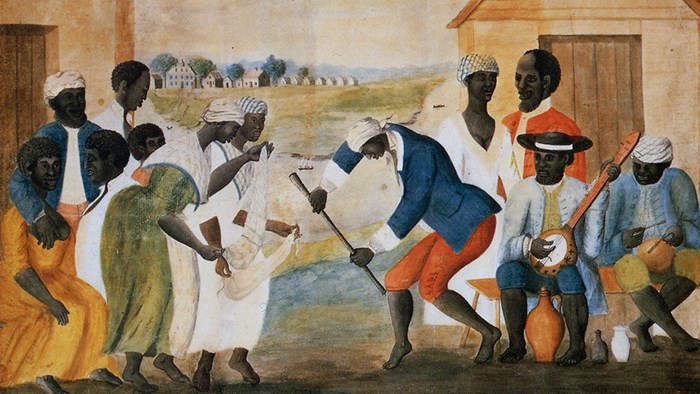
By the eve of the Civil War, Christianity had pervaded the slave community. Not all slaves were Christian, nor were all those who accepted Christianity members of a church, but the doctrines, symbols, and vision of life preached by Christianity were familiar to most.
The religion of the slaves was both visible and invisible, formally organized and spontaneously adapted. Regular Sunday worship in the local church was paralleled by illicit, or at least informal, prayer meetings on weeknights in the slave cabins. Preachers licensed by the church and hired by the master were supplemented by slave preachers licensed only by the spirit. Texts from the Bible, which most slaves could not read, were explicated by verses from the spirituals. Slaves forbidden by masters to attend church or, in some cases, even to pray, risked floggings to attend secret gatherings to worship God.
His own experience of the “invisible institution” was recalled by former slave Wash Wilson:
“When de niggers go round singin’ ‘Steal Away to Jesus,’ dat mean dere gwine be a ’ligious meetin’ dat night. De masters … didn’t like dem ’ligious meetin’s so us natcherly slips off at night, down in de bottoms or somewhere. Sometimes us sing and pray all night.”
Master’s Preachin’, Real Preachin’
Slaves frequently were moved to hold their own religious meetings out of disgust for the vitiated gospel preached by their masters’ preachers. Lucretia Alexander explained what slaves did when they grew tired of the white folks’ preacher: “The preacher came and … he’d just say, ‘Serve your masters. Don’t steal your master’s turkey. Don’t steal your master’s chickens. Don’t steal your master’s hawgs. Don’t steal your master’s meat. Do whatsomever your master tells you to do.’ Same old thing all the time.… Sometimes they would … want a real meetin’ with some real preachin’.… They used to sing their songs in a whisper and pray in a whisper.”
Slaves faced severe punishment if caught attending secret prayer meetings. Moses Grandy reported that his brother-in-law Isaac, a slave preacher, “was flogged, and his back pickled” for preaching at a clandestine service in the woods. His listeners were flogged and “forced to tell who else was there.”
Slaves devised several techniques to avoid detection of their meetings. One practice was to meet in secluded places—woods, gullies, ravines, and thickets (aptly called “hush harbors”). Kalvin Woods remembered preaching to other slaves and singing and praying while huddled behind quilts and rags, which had been thoroughly wetted “to keep the sound of their voices from penetrating the air” and then hung up “in the form of a little room,” or tabernacle.
On one Louisiana plantation, when “the slaves would steal away into the woods at night and hold services,” they “would form a circle on their knees around the speaker who would also be on his knees. He would bend forward and speak into or over a vessel of water to drown the sound. If anyone became animated and cried out, the others would quickly stop the noise by placing their hands over the offender’s mouth.”
A description of a secret prayer meeting was recorded by Peter Randolph, who was a slave in Prince George County, Virginia, until he was freed in 1847: “The slave forgets all his sufferings, except to remind others of the trials during the past week, exclaiming: ‘Thank God, I shall not live here always!’ Then they pass from one to another, shaking hands, and bidding each other farewell.… As they separate, they sing a parting hymn of praise.”
Two Extremes
Many slaveholders granted their slaves permission to attend church, and some openly encouraged religious meetings among the slaves. Baptisms, marriages, and funerals were allowed to slaves on some plantations with whites observing and occasionally participating. Annual revival meetings were social occasions for blacks as well as for whites. Masters were known to enjoy the singing, praying, and preaching of their slaves. Nevertheless, at the core of the slaves’ religion was a private place. For no matter how religious the master might be, the slave knew that the master’s religion did not countenance prayers for his slaves’ freedom in this world.
The religious format varied from plantation to plantation for the slaves. Former slave John Brown depicted two extremes: “Sunday was a great day around the plantation. The fields was forgotten, the light chores was hurried through, and everybody got ready for the church meeting. It was out of the doors, in the yard.… Master John’s wife would start the meeting with a prayer and then would come the singing—the old timey songs. But the white folks on the next plantation would lick their slaves for trying to do like we did. No praying there, and no singing.”
Some masters did not allow their slaves to go to church and ridiculed the notion of religion for slaves because they refused to believe that Negroes had souls. Others forbade their slaves to attend church because, as an ex-slave explained, “White folks ’fraid the niggers git to thinkin’ they was free, if they had churches ’n things.”
Boisterous Baptisms
Accompanied by song, shouting, and ecstatic behavior, baptism—especially for Baptists—was perhaps the most dramatic ritual in the slave’s religious life. “De biggest meetin’ house crowds was when dey had baptizing’,” noted a former Georgia slave. “Dey dammed up de crick on Sadday so as it would be deep enough on Sunday.… At dem baptizin’s dere was all sorts of shouting and dey would sing ‘Roll, Jordan, Roll, De Livin’ Waters,’ and ‘Lord, I’se Comin’ Home.’ ”
Dressed in white robes and attended by the “brothers and sisters,” the candidates proceeded “amidst singing and praises” to the local pond or creek, symbol of the river Jordan, where, according to Baptist practice, each was “ducked” by the preacher. Sometimes the newly regenerate came up from the baptismal waters shouting for joy at being made new in the Lord.
Recollecting the baptism of his mother, Isaiah Jeffries has left a description which conveys something of the excitement and the sense of new beginning which “baptizings” brought to many slaves: “When I to be a big boy, my Ma got religion at de Camp meeting at El-Bethel. She shouted and sung fer three days, going all over de plantation and de neighboring ones, inviting her friends to come to see her baptized and shouting and praying fer dem. She went around to all de people dat she had done wrong and begged dere forgiveness. She sent fer dem dat had wronged her, and told dem dat she was born again and a new woman, and dat she would forgive dem. She wanted everybody dat was not saved to go up wid her.… My Ma took me wid her to see her baptized, and I was so happy dat I sung and shouted wid her. All de niggers joined in singing.”
Slave Preachers
Presiding over slave baptisms, funerals, and weddings was the slave preacher, leader of the slaves’ religious life and an influential figure in the slave community. Usually illiterate, the slave preacher often had native wit and unusual eloquence.
Carefully watched and viewed with suspicion, the preacher had to straddle the conflict between the demands of conscience and the orders of the masters. Anderson Edwards reflected on the difficulty he experienced as a slave preacher in Texas: “I been preachin’ the gospel and farmin’ since slavery time.… When I starts preachin’ I couldn’t read or write and had to preach what massa told me and he say tell them niggers iffen they obeys the massa they goes to Heaven but I knowed there’s something better for them, but daren’t tell them kept on the sly. That I done lots. I tell ’em iffen they keeps prayin’ the Lord will set ’em free.”
By comparison with other slaves, some preachers were privileged characters. One former slave from Alabama remarked that “Nigger preachers in dem times wuz mighty-nigh free.” As long as he didn’t interfere with other slaves’ work, he [the slave preacher] was allowed to hold services whenever he wished, and frequently he traveled to neighboring places to conduct prayer meetings. It was from the preacher, this relatively mobile and privileged slave, that the rest “first heard of the Civil War.” During the war he offered whispered prayers for the success of the Union Army.
“What wonderful preachers these blacks are!” exclaimed one correspondent from Georgia to the editor of the American Missionary: “I listened to a remarkable sermon or talk a few evenings since. The preacher spoke of the need of atonement for sin. ‘Bullocks c’dn’t do it, heifers c’dn’t do it, de blood of doves c’dn’t do it—but up in heaven, for thousan and thousan of years, the Son was saying to the Father, “Put up a soul, put up a soul. Prepare me a body, an I will go an meet Justice on Calvary’s brow!” ’ He was so dramatic. In describing the crucifixion he said: ‘I see the sun when she turned herself black. I see the stars a fallin from the sky, and them old Herods coming out of their graves and goin about the city, an they knew ’twas the Lord of Glory.’ ”
Were the slave preachers a force for accommodation to the status quo or a force for the exercise of slave autonomy? On the one hand, the slave preacher was criticized by former slaves as the “mouthpiece of the masters.” On the other hand, some slave preachers preached and spoke of freedom in secret.
The weight of slave testimony suggests that the slaves knew and understood the restrictions under which the slave preacher labored, and that they accepted his authority not because it came from the master but because it came from God. They respected him because he was the messenger of the gospel, one who preached the word of God with power and authority, indeed with a power which sometimes humbled white folk and frequently uplifted slaves.
For a black man and a slave to stand and preach with eloquence, skill, and wisdom was in itself a sign of ability and talent which slavery’s restrictiveness could frustrate but never completely stifle.
Spirituals
Unable to read the Bible for themselves and skeptical of their masters’ interpretation of it, most slaves learned the message of the Christian gospel and translated it into songs in terms of their own experience. As John Dixon Long observed, “Many of them could state the cardinal doctrines of the gospel in the language of song.” It was in the spirituals, above all, that the characters, themes, and lessons of the Bible became dramatically real and took on special meaning for the slaves.
Drawing from the Bible, Protestant hymns, sermons, and African styles of singing and dancing, the slaves fashioned a religious music which expressed their faith in “moving, immediate, colloquial, and, often, magnificently dramatic terms.” Spirituals are too often seen simply as words and notes printed on a page. What must be recognized is that they emerged as communal songs, heard, felt, sung and often danced with hand-clapping, foot-stamping, headshaking excitement.
Conversion
In 1901 W.E.B. Du Bois wrote a classic essay, “Faith of the Fathers,” in which he distinguished the three characteristics of the slaves’ religion as being the preacher, the music, and the frenzy or shouting. He might well have added a fourth characteristic, the conversion experience.
The experience of conversion was essential in the religious life of the slaves. For the only path to salvation lay through that “lonesome valley” wherein the “seekers” underwent conversion, an experience which they treasured as one of the peak moments in their lives.
The typical conversion experience was preceded by a period of anxiety over one’s salvation which lasted for days or even weeks. Josiah Henson, at the age of 18, was struck by the words of a sermon he heard, “Jesus Christ, the Son of God, tasted death for every man; for the high, for the low, for the rich, for the poor, the bond, the free, the negro in his chains, the man in gold and diamonds.” Henson recalled, “I stood and heard it. It touched my heart and I cried out: ‘I wonder if Jesus Christ died for me.’ ”
Of his conversion George Liele wrote:
“I was convinced that I was not in the way to heaven, but in the way to hell. This state I laboured under for the space of five or six months.… I was brought to perceive that my life hung by a slender thread, … and I found no way wherein I could escape the damnation of hell, only through the merits of my dying Lord and Savior Jesus Christ.…” Abandoning himself to prayer, Liele found relief and “felt such love and joy as my tongue was not able to express. After this I declared before the congregation of believers the work which God had done for my soul.…”
At the center of the evangelical Protestant tradition, the tradition which slaves increasingly made their own, stood the experience of conversion.
Other Beliefs
Some slaves rejected Christianity and preserved their traditional African beliefs or their belief in Islam. Other slaves accepted Christianity of a different type—Catholicism. Relatively few slaves, mainly concentrated in southern Louisiana and Maryland, were Roman Catholics. According to a generous estimate, the number of black Catholics, free and slave, at the time of emancipation was one hundred thousand [out of approximately four million]. The predominant religious tradition, then, among the slaves and their descendants in the United States was evangelical Protestantism.
Comin’ into Canaan
Slaves believed that God had acted, was acting, and would continue to act within human history and within their own particular history as a peculiar people, just as long ago he had acted on behalf of another chosen people, biblical Israel. Moreover, slave religion had a this-worldly impact, not only in leading some slaves to acts of external rebellion, but also in helping slaves to assert and maintain a sense of personal value—even of ultimate worth. That some slaves maintained their identity as persons, despite a system bent on reducing them to a subhuman level, was certainly due in part to their religious life.
Dr. Albert J. Raboteau is Henry W. Putnam Professor of Religion and chairman of the religion department at Princeton University. He is author of Slave Religion: The ‘Invisible Institution' in the Antebellum South (Oxford, 1978), from which this article is excerpted by permission.
Copyright © 1992 by the author or Christianity Today/Christian History magazine.
Click here for reprint information on Christian History.

Support Our Work
Subscribe to CT for less than $4.25/month
